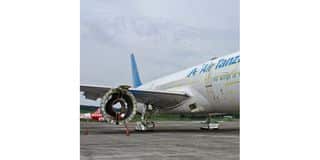Dar es Salaam. It has been revealed that an Air Tanzania plane, a Boeing 787-8 Dreamliner, has been grounded in Kuala Lumpur, Malaysia, for close to eight months, with little known about the aircraft’s maintenance status, although the national carrier, Air Tanzania Company Limited (ATCL), says the jet is set to fly again next month.
The aircraft, registered as 5H-TCJ and christened Rubondo Island (Hapa Kazi Tu), is parked at the ex-Low Cost Carrier Terminal (LCCT) area in Kuala Lumpur, appearing forlorn with both its Rolls-Royce Trent engines removed, which has raised questions given the aircraft’s relatively young age.
Speaking to The Citizen about the presence of the aircraft in Kuala Lumpur, ATCL’s Director General Ladilaus Matindi said the plane was taken to Malaysia for mandatory maintenance in November 2023.
“This is why it appears to be missing both engines. Due to the high number of engines requiring mandatory maintenance and the scarcity of rental engines, aircraft often have to wait for their turn for engine maintenance to arrive and be completed,” said Matindi
ATCL plane grounded in Malaysia. Photo | Instagram @malaysianwings2.0
According to Mr Matindi, maintenance work on these engines is expected to be completed early next month and for the aircraft to return to Tanzania.
He did not, however, say how the almost eight-month delay had affected the operations of the national carrier.
Delivered in July 2018 at a cost of $224.6 million, the 787-8 Dreamliner was the fourth aircraft to be purchased by the Tanzanian government in an effort to revamp the ailing national carrier, Air Tanzania.
In October 2022, the national carrier grounded three of its four Airbus A220-300 twin jets after they developed technical issues with their Prat and Whitney engines.
Though one of the planes returned into operation a month later, the saga escalated after ATCL took the matter to the African Airlines Association (AFRAA), with four airlines collaborating to pressurize the manufacturers to find a solution.

ATCL plane grounded in Malaysia. Photo | Instagram @malaysianwings2.0
In another development, the Bombardier Q300 aircraft, which has been in Malta since 2020, is set to return home in June.
“Its maintenance has already been completed, and it is awaiting test flights and the replacement of the landing gear system,” said Mr Matindi.
Late last year, it emerged that another ATCL plane, a Bombardier Q 300 had been grounded for three years after a major malfunction forced its journey to the European nation for major repairs.
ATCL attributed the extended stay of the plane in Malta to its age and the difficulty in sourcing spare parts for the required overhaul.















